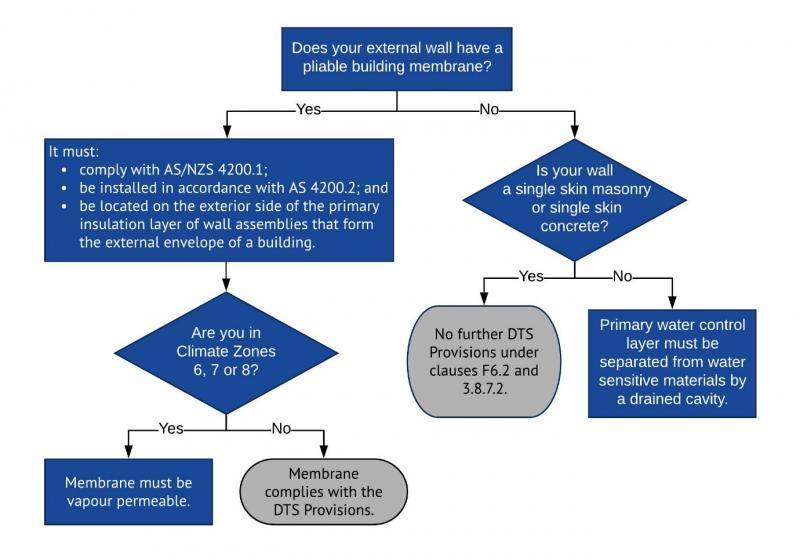The purpose of this article is to assist builders and designers in complying with the new DTS Provisions for the use of pliable building membranes in clauses F6.2 and 3.8.7.2.
Readers should note that the NCC condensation management DTS Provisions also contain requirements for exhaust systems and ventilated roof spaces, which are not covered in this article.
These provisions require ‘risks associated with water vapour and condensation must be managed to minimise their impact on the health of the occupants’ and apply to Class 1 buildings, sole-occupancy units (SOUs) of Class 2 buildings, and Class 4 parts of buildings.
Compliance pathways
To comply with these new requirements you can follow the Deemed-to-Satisfy (DTS) Provisions outlined in Part F6 (Volume One) and Part 3.8.7 (Volume Two) or use the Verification Methods FV6 (Volume One) or V2.4.7 (Volume Two). Alternatively, you could do a Performance Solution from first principles. For more information about Performance Solutions, see the Resource Library.
DTS Provisions
The intent of the condensation DTS Provisions is to assist the mitigation of condensation within a building, mainly focusing on allowing water vapour to escape the building envelope. It's important to note that installing a condensation management system may not prevent condensation in all instances. As part of design and construction, designers and builders have a responsibility to assess product specifications and wall designs to ensure buildings perform as intended. The NCC’s new condensation management provisions for pliable building membranes need to be considered where one is installed, regardless of whether it was required by the NCC.
The figure below provides a flow chart of the DTS Provisions for condensation management using pliable building membranes.

Wall Assemblies With Pliable Building Membranes
When using a pliable building membrane, there are two key points to consider:
- Is a pliable building membrane required?
- Does the pliable building membrane need to be vapour permeable?
A pliable building membrane may be required for different reasons such as weatherproofing purposes, energy efficiency (i.e. part of the total R Value of the envelope) or managing condensation. In some instances it's also common practice to install a pliable building membrane where it's not strictly required. As an example, a builder or designer might include a pliable building membrane as an extra layer of weatherproofing/insulation or to protect water sensitive materials. In this situation, whilst well-intentioned, it might inadvertently create a risk associated with water vapour and condensation.
When thinking about whether a pliable building membrane needs to be vapour permeable or not, how the water vapour moves through the building envelope needs to be considered. A pliable building membrane is often placed on the external side of water sensitive materials. This may prevent water vapour from escaping the building envelope, creating a situation where condensation accumulates on the internal side of the pliable building membrane (where the water sensitive materials are located). Subclause F6.2(a) and 3.8.7.2(a) address this issue by requiring that pliable building membranes installed in cooler climate zones 6, 7 and 8 be vapour permeable membranes regardless of why they have been installed.
Wall Assemblies Without Pliable Building Membranes
Single skin, reinforced masonry construction is a very common form of construction used for DTS compliance in cyclonic areas, particularly for houses. Single skin masonry and concrete walls are exempted from requiring either a cavity or a pliable building membrane by subclauses F6.2(b) and 3.8.7.2(b). However, it should be noted that weatherproofing of these wall assemblies may still be necessary.
A reverse brick veneer construction with no cavity is not considered ‘single skin masonry. ’ It would therefore require, either, a pliable building membrane, or a drained cavity separating the primary water control layer from water sensitive materials to satisfy the condensation management DTS Provisions.
Additional information
Read our Condensation in Buildings Handbook to find out more about condensation management. The ABCB is updating this handbook to incorporate the NCC 2019 requirements and it's expected to be released in late 2019.